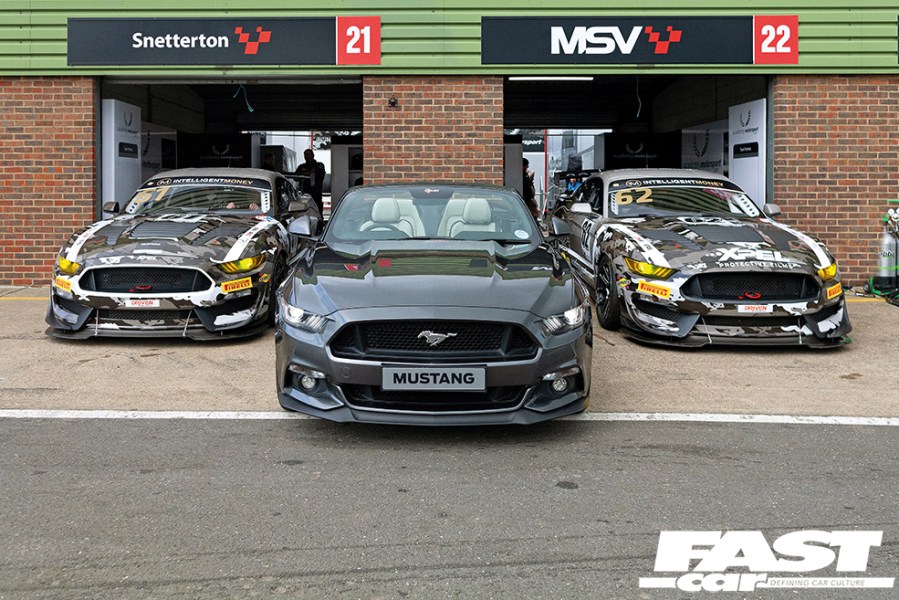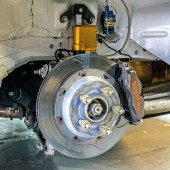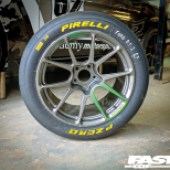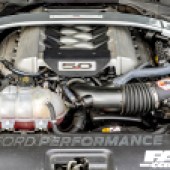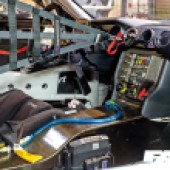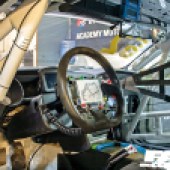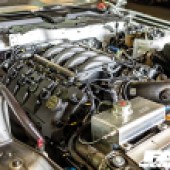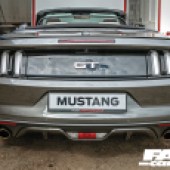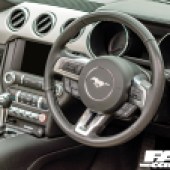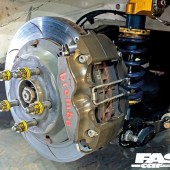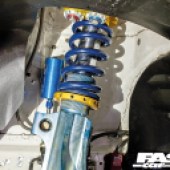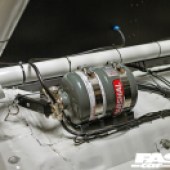British teams ran winning Mustangs at the start of the model’s history, 56 years ago. Today, the Mustang GT4 and the road-going Mustang GT are pitched against each other to see just how different they really are.
From Fast Ford. Words: Mike Rysiecki. Photos: Leigh Jones
It was the British Alan Mann Racing team that delivered the Mustang’s first ever competition victory on the Tour de France Auto, way back in 1964. European Touring Car and British Saloon Car Championship wins followed, starting a competition history that is still being added to today.
Ford introduced a right-hand-drive version of its latest S550 Mustang to world markets late in 2015, and well over 10,000 examples are now on UK roads. More than 50,000 have been sold across Europe, adding to its title as the world’s best-selling sports car. In its remarkable 56th year of continuous production, racing Mustangs are proving as fierce a foe as ever on the world’s racing circuits, particularly in championships such as British GT and European GT4 racing.
Mustang GT road cars need to meet different emissions and homologation standards in order to be sold globally; likewise GT race championships have their own sets of rules. The similarity between road and race homologation breaks down at this point; for road use, manufacturers need to accommodate different customs and local regulations for things like lighting and ‘drive-handing’. In the racing world, sanctioning bodies seek to standardise and maximise eligibility across the globe. No such need to accommodate left- and right-hand drive in international motorsport – all Mustang GT4 race cars come in LHD.
The SRO Motorsports-sanctioned GT championships are run to a ‘balance of performance’ (BoP) formula. Under that BoP, the power, torque, weight and aerodynamic characteristics of each participating model are inspected, measured, analysed and then compared on track by a pair of independent drivers with the aim of getting each car to be capable of lapping within 0.3 seconds of the others on any style of circuit design. It’s a formidable task, which results in a level playing field on which cost escalation is controlled to prevent expensive power wars and ensure exciting, close racing.
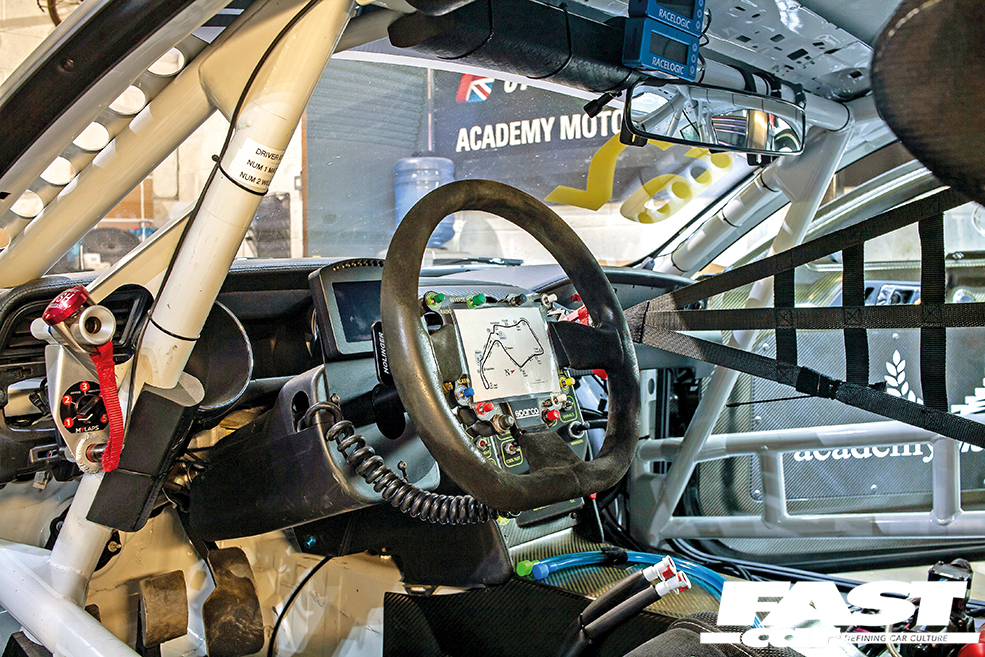
The proof is in the execution, where starting grids are often determined within the same lap time second and where SRO’s performance code is used across the globe. Control points are typically applied using throttle aperture diameter, weight and ride-height to even out overall performance.
Although the finished products are very different machines, race cars actually started life in the same place as road cars – on the production line at Ford’s Flat Rock assembly facility near Detroit, Michigan.
After that, the cars went their separate ways; GT road cars were completed at Flat Rock, while Mustang GT4 racers left the Michigan body assembly plant as a fastback ‘body-in-white’ and were shipped to the Multimatic Motorsports facility in Ontario, Canada, to finish their build as a race car. Here they were fitted with race-specification Roush-Yates V8s and various motorsport upgrades.
To highlight the differences between road and race cars, we grabbed a GT convertible road car (which, today, is about as far away as you can get from the GT4 race cars, even though both cars went down the same production line at about the same time) and compared it to the latest 2020 Mustang GT4 racers from Academy Motorsport.
Here’s how the two Mustangs compare and contrast…
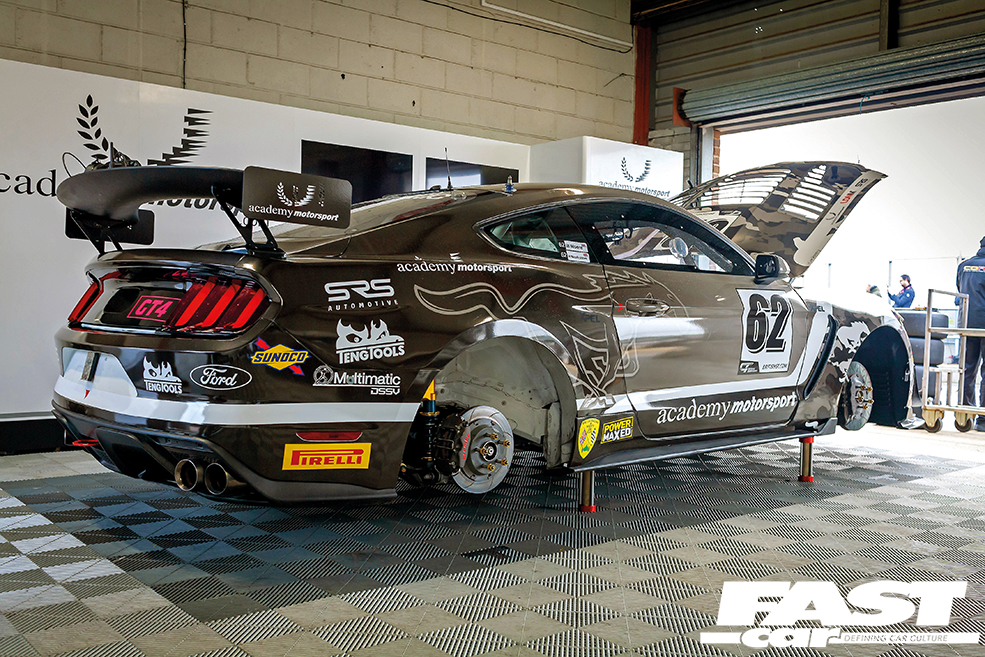
Mustang GT4 vs GT:
Chassis/Body
All S550 Mustangs start life at the Flat Rock, Michigan assembly plant where, for the first time, left- and right-hand drive variants are built on the same line. Some right-hand-drive variations, such as special springs for our British road surfaces, are ‘post-processed’ away from the production line before shipping to the UK. All British GTs are Performance Pack-equipped with lowered suspension and larger Brembo brakes.
Just as in the Mustang’s home market, an aftermarket performance and appearance industry has grown in the UK to meet the needs of Mustang owners wanting their car to look and go like the high-performance models that are not available in the UK. Faux-Shelby body stripes are one of the most popular cosmetic additions to UK fastbacks. Tightening up any slack at the suspension is another common mod, which has been previously well documented in Fast Ford magazine.
The first step for a Mustang GT4 race car, which leaves the Flat Rock assembly plant as a LHD body-in-white fastback, is a visit to a Multimatic subcontractor for seam (stitch) welding and some bulkhead sheet metal modification to accommodate a dry-sump lubrication tank. From there, Multimatic Motorsports takes over the roll cage and systems fit-out at the firm’s base in Markham, Ontario, Canada. Carbon fibre is used extensively for the roof, doors, bonnet and boot lid, along with polycarbonate substitution for the windows. Subsequent ancillary systems can then be added and positioned helpfully, to achieve better weight distribution. The cars have to meet a race regulation minimum weight of 1545kg, which is 113kg lighter than the production Shelby GT350.
The external aero was designed using lessons learned by the same team on the Le Mans-winning Ford GT racing programme. Bonnet louvres, splitter, canards and rear wing work in concert to define a lightweight, drag-cheating yet effective downforce package that reveals its advantages on the most famous of British GT circuit corners.
Like most British GT race cars, Academy’s Mustangs are body-wrapped. Academy’s is a distinctive grey and white ‘galloping pony’ Rob Weston design, applied across the team’s transporters and race cars at SRS Automotive.
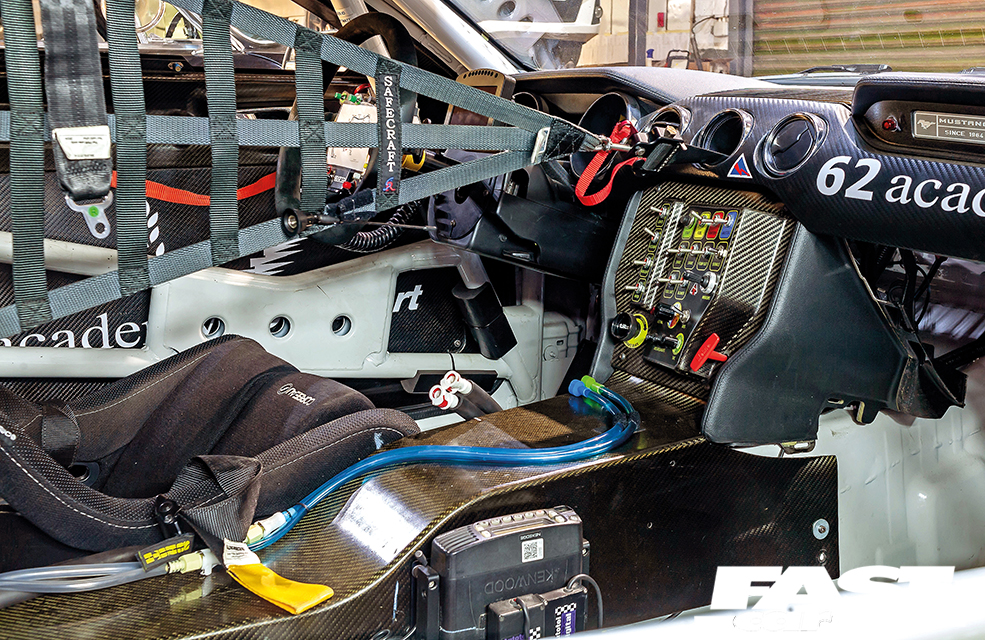
Transmission
Ford reports a roughly 50/50 split of auto versus manual transmissions selected for new Mustangs by UK buyers. Although the autos, which offer a choice of different shifting strategies, are quicker (even more so with a 2018-on ten-speed) many traditionalists still want to feel a mechanical connection through their left palm. The manual gearbox can be a slow shifter and you’d want to be driving a rental example, rather than one you own, to extract maximum acceleration. On many tracks you’ll mostly use third and fourth once under way, so other than being able to respond to shouts of ‘rev it, mate!’ auto converts find it hard to see the point of three-peddling. For those adding forced-induction, there are even more reasons to deliver the additional power through the driveline friendliness of an auto-shifter.
On the GT4 race car the manual shift is pneumatically assisted, and the straight-cut gears in the Holinger gearbox do not require the use of the clutch once in motion. Flappy paddles are used to control the sequential shift action while compressed air fires like a rifle shot up and down the gears. The chance of missing a gear is minimal.
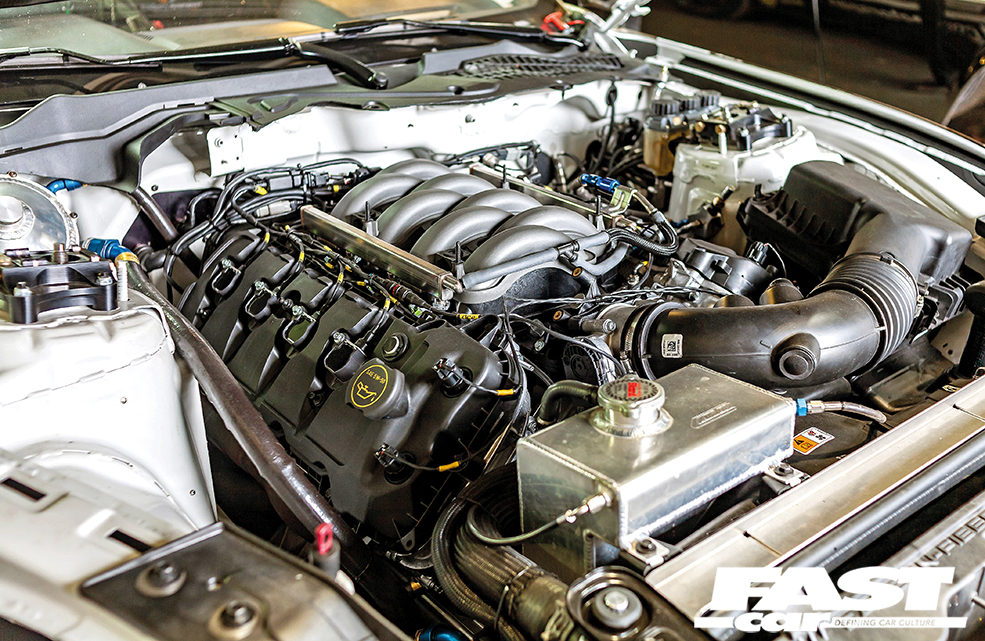
Engine
The Coyote V8 engine was specifically designed for the Mustang GT and was a logical – yet significant – step-change from the previous 4.6-litre V8 engines.
Having had the muscle car market to itself for the best part of the previous decade, returning to a legendary 5.0 engine size was necessary for Ford to take on new 6.2-litre LS3 Camaros and 6.4-litre Hemi-engined Challengers. Chevrolet and Dodge had stayed in their comfort zones with single-cam, pushrod eight-valvers but Ford pushed the modern and exotic multi-valve V8 configurations still further and adopted Twin Independent Variable Cam Timing (Ti-VCT) with cam torque-actuation across 32 valves. In short, Ford was able to get the same or better power from its cleaner-burning, higher-revving, state-of-the-art engine without having to resort to economy/emissions measures like cylinder deactivation. Here is an engine that sounds and performs like a modern version of America’s preferred cylinder configuration under all conditions.
The aftermarket industry wasted no time in extracting more power from the Coyote by developing a range of intake, exhaust and forced induction options for those wanting to push 500bhp and beyond. Ford got the GT350 up to 526hp with a naturally-aspirated 5.2 flat-plane-crank Voodoo version of the engine, the championship-winning Ford Shelby GT350R-C version of which forms the basis of the GT4 race car.
The GT4 engine is a special Roush Yates-built Coyote 5.2-litre derivative designed specifically for the Balance of Performance (BoP) formula, thereby making it eligible for numerous racing series around the world. Although the GT4 uses Voodoo engine cylinder heads that are capable of 8000rpm-plus, this engine runs a cross-plane crankshaft. With a power cap of 450bhp embedded in the BoP GT4 regulations, robust reliability and smooth power delivery is preferred over the peakier power characteristics of the even-higher-revving Voodoo flat-plane crank.
For many V8 Mustang owners it’s all about the sound and there is no chance of mistaking the GT4 Mustang for a European exotic on track as the iconic V8 rumble comes with the cross-plane cylinder 1-5-4-8-6-3-7-2 firing order. Owners of GT road cars seeking an even deeper and more nostalgic sound are prone to fitting H-pipes, sacrificing the obvious advantages provided by the GT4’s X-pipe exhaust configuration for old-school rumble. Race cars utilise the standard factory airbox and filter.
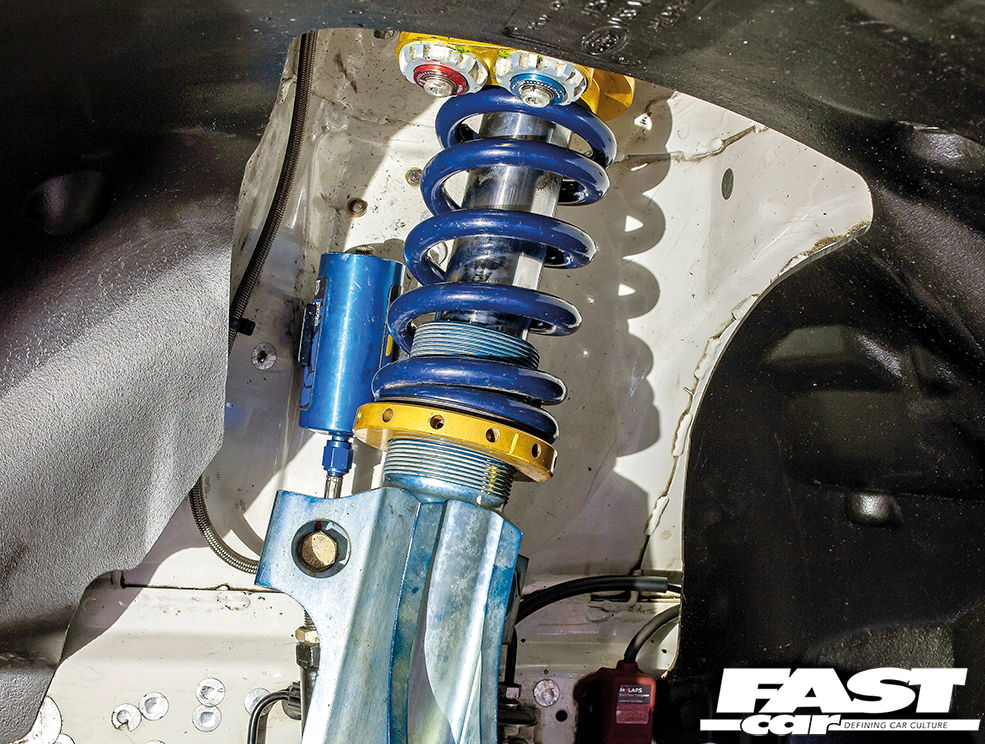
Suspension
The introduction of the S550 Mustang in 2015 will be remembered as the moment that doubters could no longer claim Mustangs were only ‘okay for straight lines’, and independent rear suspension finally brought the car’s handling into the 21st century. So dramatic was the change brought about by the new multi-link arrangement that Ford’s chassis engineers had to rework the front suspension to deliver matching ends of sophistication. Even though aftermarket suspension tuning vendors had persuaded the previous solid rear axle to behave, in the end it was only drag racers who lamented the departure of their beloved strong (but antiquated) arrangement.
All UK Mustang GTs are delivered with the otherwise-optional Performance Pack, which means stiffer, lower suspension. It’s a true grand touring setup that, although perfect for distance cruising, causes many owners to fit even lower, stiffer springs and wheel spacers for appearance and performance reasons.
The suspension can also be sharpened with a variety of aftermarket bolt-on parts, which tighten up the slack and make for a more consistent driving experience. A front strut brace is a popular addition, so too is chassis bracing, especially to that new IRS rear end. The convertible model has plenty of additional bracing and is much stiffer than any previous generations of soft-top Mustangs, while MagneRide is an option on all post-2018 cars, with electronically-controlled automatic variable damping.
Competition car development is an area where Multimatic excels; the team’s in-house expertise in vehicle dynamics, simulation, composite materials and niche vehicle development is race-proven. If there is a ‘secret sauce’ in GT4 Mustangs it’s in the all-round Multimatic adjustable cartridge-type dampers with DSSV spool-valve damping technology. DSSV shocks helped to win five Champ Car championships, four Formula 1 world championships, and are standard fit on a long list of high-performance cars like the Ford GT, Aston Martin One, Mercedes-AMG GT, Ferrari 458/488 GT3 and GT3LM. They are also the spec damper for numerous racing series such as DTM and were used by over half of Le Mans 24 Hours entries. Whereas conventional shock absorbers rely on flexible disc shims, DSSV technology is characterized by the use of spool valves and an external fluid reservoir. Disc shims have a reputation for unpredictability and can be inconsistent under the stress of racing. Multimatic’s product gains its popularity from the precision, predictability, repeatability and robust performance that transforms the Mustang’s handling on-track.
Up front, the adjustable coil-over MacPherson struts have race-specific bushings and ball joints. The rear multi-link IRS has Multimatic-designed lower control arms, race-specific bushings, ball joints, and of course, Multimatic DSSV adjustable shock absorbers. Blade-adjustable front and rear anti-roll bars complete the sophisticated suspension package.
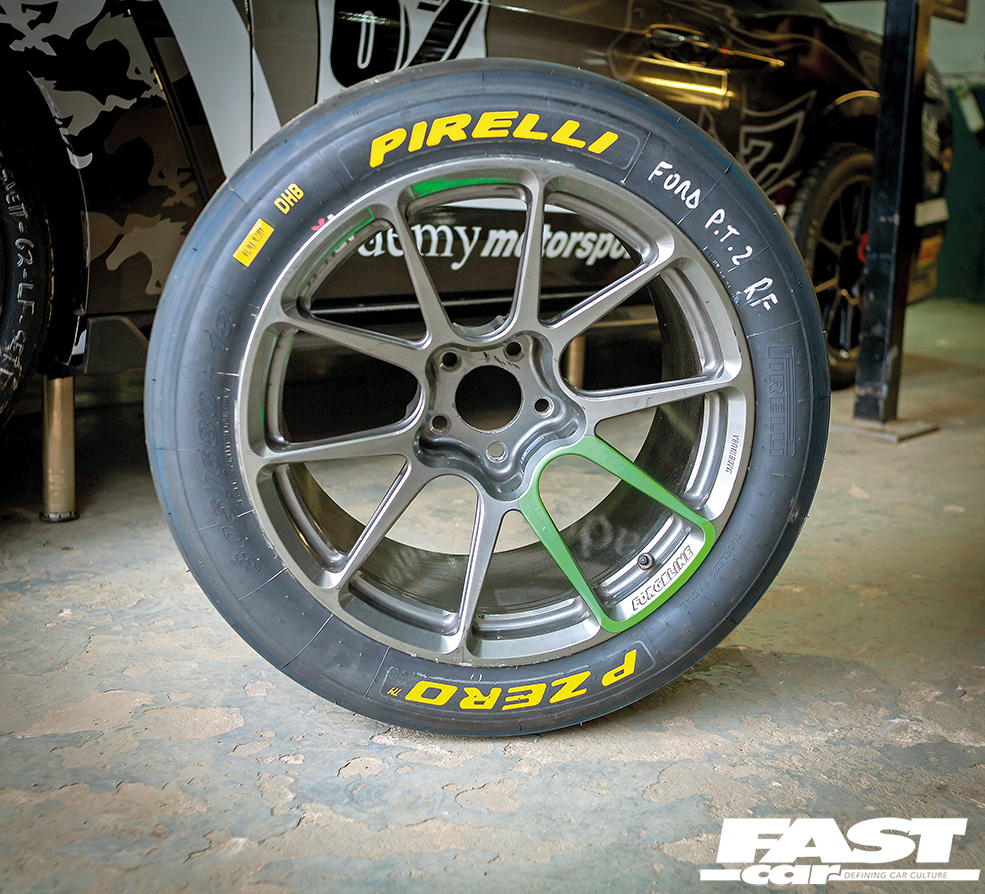
Wheels & Tyres
Road-going GTs come with staggered 19in alloys, 9in at the front and 9.5in at the rear. Pirelli P Zeros were factory fit and troublesome for some owners making the switch from front-wheel-drive and using the Mustang as a daily driver in winter; well-known as a summer tyre that is at its best above 7°C, some owners struggled with traction on colder days. From 2018-on the more forgiving Michelin Pilot Sport 4S OEM fitment has gained a loyal following. Alternative tyre brands, like Altimax One S from Continental’s General Tire, which has a long association with Saleen performance Mustangs, are beginning to be available in standard Mustang sizes in Europe.
British GT teams employ integrated air jack systems and are well-practised at changing all four wheels mid-race during endurance events. Forgeline 11x18in forged multi-spoke alloy wheels are specified across the field for GT4 racing and will clear the 380mm floating front discs. Pirelli has been the official tyre supplier to the British GT Championship since 2016 with P Zero-branded tyres. For the 2020 season the Pirelli P Zero DHB replaces last season’s DH slicks, and the Cinturato WH is retained for wet use.
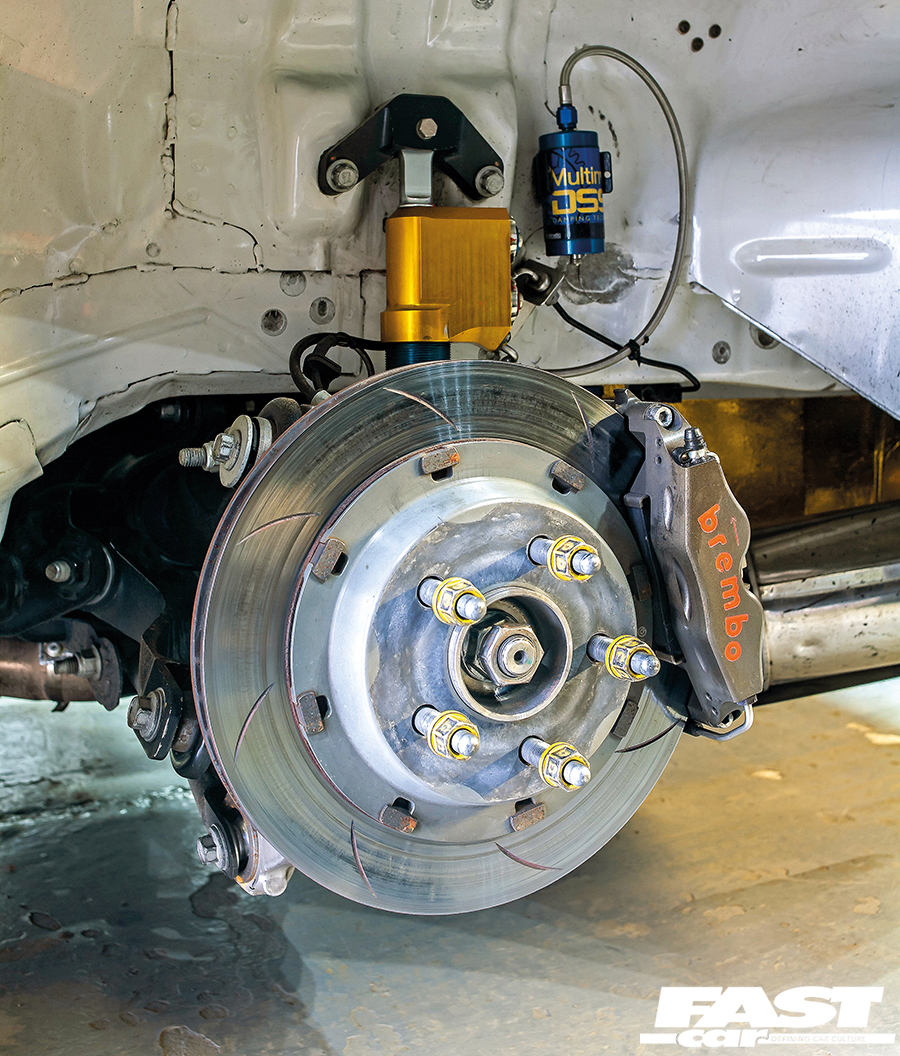
Brakes
All UK GT Mustangs are equipped with 380mm front discs and six-pot Brembo brakes, which are plenty for spirited road and occasional track use. The rear stoppers are standard Ford parts, which can be relaxed if the standard-fit line-lock feature is deployed. The race car gets Brembo six-piston front and four-pot rear callipers with fully-floating, slotted discs.
Keen followers of the British GT Championship in 2019 witnessed how Scott Maxwell and Seb Priaulx were able to use the Mustang’s braking prowess with devastating effect to outlast and out-brake their opponents when maximum braking was required at circuits like Oulton and Donington Park. As the race car’s brakes are not power-assisted, the drivers can finesse their corner approach to their advantage under braking. There is a Bosch race-tuned ABS and TC system in the mix, but in dry conditions they are set to intervene only at the very highest levels of traction torture. YouTube videos of Seb Praiulx at last year’s Donington season finale provide plenty of evidence of him combining his skill with the car’s capability for maximum advantage.
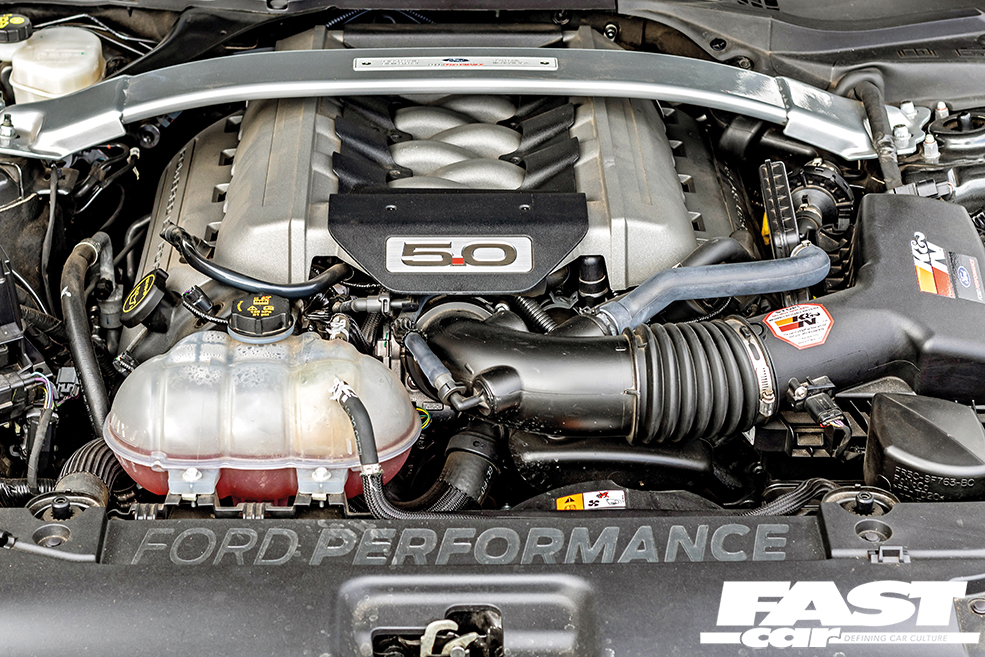
Tuning the road Mustang GT
With both the road version of the S550 and the latest Mustang GT4 racer sat side-by-side, it’s easy to highlight the quite significant differences between the two, especially as far as handling is concerned. The two are very different machines at opposite ends of the scale; one is built to cruise around in comfort and style, and the other developed to be as fast as possible on the race track. But what, if like many Mustang owners, you want to nudge your road car’s performance levels more towards those of the race car, but without compromising its abilities as a road car? Well, like many Mustang owners before, the good news is there is a wealth of tuning knowledge and a huge selection of performance upgrades available for the S550 model, offering everything from a simple sharpen-up of the existing package right through to motorsport-inspired upgrades that will give the Mustang GT4 a real run for its money.
And the really great news for us UK fans, is that the Mustang tuning market is no longer restricted to America. From street-legal 800bhp-plus supercharger conversions (check out our review of the CS800 Mustang), to rapid drag racers, to track day toys, there are plenty of highly respected UK-based specialists that you can trust to transform your S550 into the Mustang you’ve always dreamed of. We’ve put together our own fast mods guide to tuning the S550 Mustang, the potential of the Mustang really is limitless.
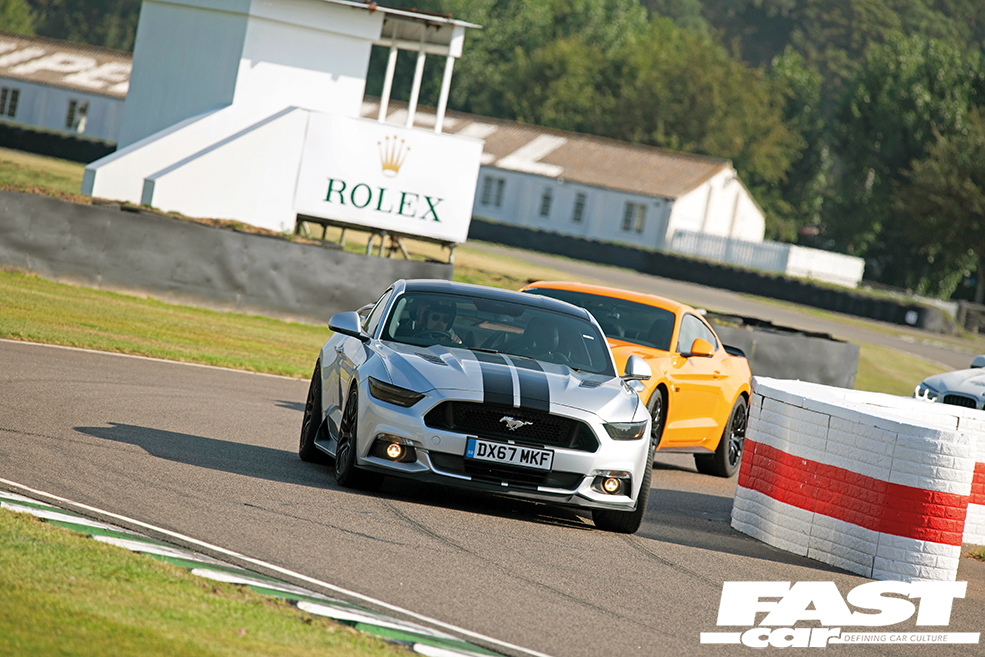
Conclusion: Mustang GT4 vs GT
Both the Mustang GT4 and the road-going GT are world-class products and price-point leaders for their respective use cases. The difference is that a road-going Mustang is just a starting point for many owners who will go on to modify and upgrade their V8 steed. For GT4 drivers, the car comes fully race-ready with no further mods required or permitted – it’s their skill, racecraft and team’s preparation that will carry them to British and European GT Championship race victories.
Tech Spec: Mustang GT4
Engine:
Naturally-aspirated, 5.2-litre 32-valve DOHC V8 racing engine developed by Ford Performance and Roush Yates Engines, Ford OE high-strength aluminium cylinder block, cross-plane crankshaft, Ford OE Voodoo cylinder heads with valvetrain capable of 8000rpm+, specifically tuned intake and exhaust systems, dry sump lubrication, motorsport engine wiring harness, Bosch Motorsport MS6 engine management system
Power:
Around 450bhp and 442lb.ft, subject to each series’ Balance of Performance requirements
Weight:
Rulebook minimum 1545kg
Transmission:
Rear-wheel drive with ZF-developed twin-plate racing clutch and flywheel, compact six-speed sequential Holinger paddle-shift transmission with direct pneumatic-activated (clutchless) gearshifts, final drive ratio: 3.31:1, GT4-specific limited slip differential
Suspension:
Front: double-ball-joint independent MacPherson strut with Multimatic Dynamic Suspension Spool Valve (DSSV) dampers and stabiliser bars, adjustable caster/camber plates; rear: integral-link independent with lower control arms designed specifically for coilover springs, DSSV dampers
Brakes:
Front: 380mm ventilated floating discs with Brembo six-piston callipers; rear: 313mm ventilated discs with Brembo four-piston callipers; ABS controlled by Bosch race-tuned M4 module; carbon fibre front brake ducts
Wheels & Tyres:
Forgeline lightweight 11x18xin forged alloy wheels, optional four-corner air-jack system, 305/680×18 Pirelli DHB P Zero slicks or Cinturato WH rain tyres
Exterior:
Unitary steel two-door fastback with carbon fibre roof, louvred bonnet, boot lid, front splitter, canards, rear diffuser and rear wing, aerodynamic enhancements derived from the Ford GT WEC racing program, polycarbonate windscreen, side and rear windows. Optional fuel system upgrade with endurance 120-litre fuel cell, twin pumps and collector
Interior:
FIA-compliant roll cage structure, plumbed-in fire extinguisher, six-point harness, FIA-homologated adjustable race seat and adjustable steering column, driver coolsuit and drinking water supply, car-to-pit radio communication system, carbon fibre trim panels, MoTeC race-oriented dash logger for full data analysis
OTR Price (when new):
$235,000 (USD)
Tech Spec: Mustang GT
Engine:
Naturally-aspirated Coyote 4951cc DOHC 32-valve V8 with aluminium block and heads, cast aluminium pistons, forged steel con rods, 11:1 compression ratio, sequential multi-port fuel injection, stainless steel tubular exhaust manifolds and twin-exit system
Power:
412bhp @ 6500rpm, 386lb.ft @ 4250rpm
Weight:
1680kg fastback/1756kg convertible
Transmission:
Rear-wheel drive with Getrag MT-82 six-speed manual gearbox or 6R80 ZF-derived automatic gearbox with paddle shifters. Torsen T-2R limited slip differential, final drive ratio: 3.55:1, electronic launch control
Suspension:
Front: double-ball-joint independent MacPherson strut and tubular anti-roll bar; rear: integral-link independent with coil springs, monotube dampers and anti-roll bar (2018-on: optional Ford MagneRide dampers)
Brakes:
Front: 380mm ventilated discs with Brembo six-piston callipers; rear: 330mm ventilated discs with floating callipers; ABS, AdvanceTrac electronic stability control, electronic line-lock
Wheels & Tyres:
Staggered Performance Pack alloy wheels; front: 9x19in with 255/40×19 Pirelli P Zero tyres; rear: 9.5x19in with 275/40×19 Pirelli P Zero tyres
Exterior:
Unitary steel two-door fastback or convertible with aluminium bonnet and front wings, auto xenon headlamps, heated power-folding door mirrors, LED tail lamps, rain-sensing wipers, GT grille and badging. Optional reversing sensors and camera
Interior:
Electrically-adjustable front seats, leather upholstery, colour touch-screen SYNC stereo with nine speakers, Apple CarPlay/Android Auto, Shaker optional upgrade, rear camera, dual-zone climate control, KeyFree with PowerStart button, MyColour ambient interior lighting. Optional Recaro seats (not convertible) or climate-control heated/cooled seats
OTR price (when new):
£33,000-£45,000

